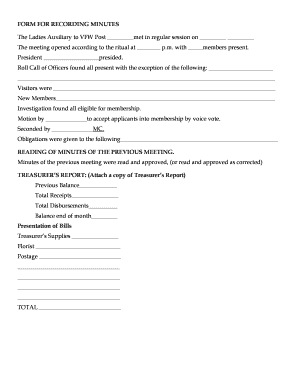Fill and Sign the Vfw Meeting Minutes Template Form

Useful suggestions for preparing your ‘Vfw Meeting Minutes Template’ online
Are you fed up with the inconvenience of managing paperwork? Look no further than airSlate SignNow, the premier eSignature platform for both individuals and businesses. Bid farewell to the tedious process of printing and scanning documents. With airSlate SignNow, you can easily complete and sign documents online. Utilize the powerful features offered by this user-friendly and affordable platform to transform your method of document management. Whether you need to authorize forms or gather eSignatures, airSlate SignNow manages everything seamlessly, requiring just a few clicks.
Adhere to this step-by-step guide:
- Sign in to your account or create a free trial with our service.
- Select +Create to upload a file from your device, cloud storage, or our template library.
- Open your ‘Vfw Meeting Minutes Template’ in the editing tool.
- Select Me (Fill Out Now) to finish the form on your end.
- Add and designate fillable fields for additional participants (if necessary).
- Continue with the Send Invite settings to solicit eSignatures from others.
- Download, print your copy, or convert it into a multi-usable template.
Don’t fret if you need to collaborate with your colleagues on your Vfw Meeting Minutes Template or send it for notarization—our platform equips you with everything required to complete such tasks. Sign up with airSlate SignNow today and elevate your document management to a new level!
FAQs
-
What is a Vfw Meeting Minutes Template?
A Vfw Meeting Minutes Template is a structured document designed to capture the key points and decisions made during VFW meetings. It helps ensure that all important information is recorded accurately and can be easily referenced in the future. Using a template streamlines the process of documenting meetings, making it efficient and organized.
-
How can I create a Vfw Meeting Minutes Template using airSlate SignNow?
Creating a Vfw Meeting Minutes Template with airSlate SignNow is simple. You can start by selecting a pre-designed template or create your own from scratch. The platform allows you to customize fields, add signatures, and ensure that all necessary information is included, making it easy to manage your meeting documentation.
-
What are the benefits of using a Vfw Meeting Minutes Template?
Using a Vfw Meeting Minutes Template offers several benefits, including improved organization and clarity in documenting meetings. It ensures that all members have access to consistent information and decisions made during meetings. Additionally, it saves time and reduces the risk of missing important details.
-
Is there a cost associated with using the Vfw Meeting Minutes Template on airSlate SignNow?
airSlate SignNow offers various pricing plans, including options that allow you to use the Vfw Meeting Minutes Template. The cost depends on the features you need and the number of users. You can choose a plan that fits your budget while still benefiting from the powerful tools available for document management.
-
Can I integrate the Vfw Meeting Minutes Template with other tools?
Yes, airSlate SignNow allows for seamless integration with various tools and applications. This means you can easily connect your Vfw Meeting Minutes Template with project management software, email platforms, and other productivity tools. This integration enhances workflow efficiency and ensures that your meeting documentation is easily accessible.
-
How does airSlate SignNow ensure the security of my Vfw Meeting Minutes Template?
airSlate SignNow prioritizes the security of your documents, including the Vfw Meeting Minutes Template. The platform employs advanced encryption and security protocols to protect your data. Additionally, you can control access permissions, ensuring that only authorized individuals can view or edit your meeting minutes.
-
Can I customize the Vfw Meeting Minutes Template to fit my organization's needs?
Absolutely! airSlate SignNow allows you to fully customize the Vfw Meeting Minutes Template to meet your organization's specific requirements. You can add or remove sections, adjust formatting, and include your organization's branding, ensuring that the template aligns with your meeting documentation standards.
Related searches to vfw meeting minutes template form
Find out other vfw meeting minutes template form
- Close deals faster
- Improve productivity
- Delight customers
- Increase revenue
- Save time & money
- Reduce payment cycles

